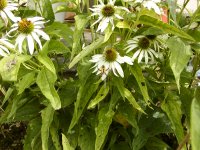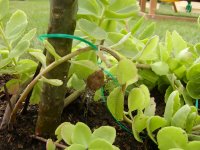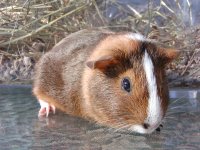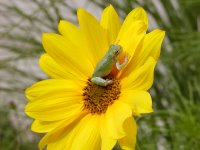Some might argue his better side...
Thursday, September 28, 2006
Tuesday, September 26, 2006
Eastern Black Swallowtail

Stage 3:

The Black Swallowtail, a.k.a., Parsnip Swallowtail, Eastern Black Swallowtail, and Parsley Worm, is one of the easiest butterflies to attract to your garden. The female will lay her eggs on virtually any member of the carrot family (Apiaceae), wild or cultivated, which includes favorites such as Parsley, Dill and Fennel (Foeniculum spp.), which they all feed on.
Both male and female Eastern Black Swallowtails are bluish-black with yellow spots on the wings. They also have two orange eyespots with black dots in the middle.
The male has a yellow band on the hind wings with a blue cloud under it. The female has a row of yellow dots above a blue band. It's easiest to remember that males have more yellow, and females have more blue.
This animal will overwinter in the chrysalis (pupal stage), meaning it won't hatch into an adult until Spring but may be seen flying as early as the end of April and as late as the end of October. The adult will drink nectar from many different flowers, including milkweeds, thistles, Red Clover, and Purple Coneflower.
The Eastern Black Swallowtails will search open spaces, such as meadows, gardens, banks of streams and ponds, marshes, and roadsides in search of nectar and mates. They usually flutter around, but when they are disturbed they fly straight.
This butterfly is a mimic, which means its pattern copies another animal. Its cousin, the Pipevine Swallowtail is poisonous to many predators. By copying the Pipevine Swallowtail, the Eastern Black Swallowtail gains protection from predators, even though it is not poisonous. This animal is most often eaten as a caterpillar.
Quiz - Read the definitions, then label the diagram below:
Definitions
- Abdomen - The abdomen is the segmented tail area of an insect that contains the heart, Malpighian tubules, reproductive organs, and most of the digestive system.
- Antenna - An antenna is a sensory appendage that is attached to the head of adult insects. Antennae are used for the sense of smell and balance. Butterflies have two antennae with clubs at the end.
- Compound Eye - Insect compound eyes are made up of many hexagonal lenses.
- Fore wing - The fore wings are the two upper wings.
- Head - The head is the part of the insect that contains the brain, two compound eyes, the proboscis, and the pharynx (the start of the digestive system). The two antennae are attached to the head.
- Hind wing - The hind wings are the two lower wings.
- Leg - All adult butterflies have six legs. The two forelegs of some butterfly species are tiny.
- Proboscis - Adult butterflies sip nectar and other liquids using a spiral, straw-like proboscis located on their head.
- Thorax - The thorax is the body section between the head and the abdomen. The legs and wings attach to the thorax.
Sunday, September 24, 2006
Raising a Greenhouse
Well, we didn't actually raise the greenhouse, not this past weekend anyway, we finally covered it (again)!
When we first installed the greenhouse back in 1998 or 1999, we covered it with two layers of 6mil plastic. This was a four year plastic that happened to last almost six years - I guess because we doubled it. However, the New England weather took it's toll - of course the wild turkeys that decided to roost on the ridge didn't help either but rather helped it's demise along by sinking their claws through the plastic to grip the ridge bar. Covering it back then was a challenge and I was younger and a tad bit lighter, svelte, but let's not get into specifics and waist sizes...
The greenhouse has sat uncovered now for a couple years, not being used. All the 'stuff' that was inside still sitting where it was when it was covered, only now it's ruined and useless. The goal now is to get the ends built, the woodstove installed, clean ALL that 'stuff' out , get the plants in before the first New England frost and get the greenhouse back up and running.
How bout some specs on this here greenhouse:
48' long
30' wide
12' floor to ridge
We purchased a new 100' roll of 6mil plastic and yes, it's quite heavy. Once again we rolled it out (on the neighbors lawn) and cut it in half - it went on it two pieces. Once on, the ends needed to be secured. Now this might sound failrly straight forward, however, there are approximately 50 bolts that need to installed on each end. The problem here is that each bolt needs to cut through 2 layers of plastic to get a grip on the threads. The bolts do not have points on the end but rather they're flat, also short. Anyway, we got it done despite it being on the windy side too and it only took about 5 hours.
At one point this entire greenhouse was full of beautiful flowers with a sea of colors. I can't tell you how satisfying it is to finally see it covered and on the road to being used again. The anticipation will be well worth waiting for!
Here are ‘before and after’ pictures:
Before:
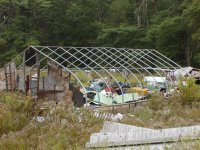
After:

Friday, September 22, 2006
Orb Weaver - UPDATE
It was only a couple days later that we discovered her, not too far from where we let her go, in a brandy new web she built just waiting for dinner to arrive. Here is a picture of her -
I spent this past Saturday in the yard planting some new perennials, splitting and transplanting some daylilies, etc. I've had this one Sedum plant that's been confined to a pot all summer long. It was planted along with a small Plumeria cutting. I should have separated the two in the spring but it didn't happen. So with the pending arrival of fall/winter I thought now would be a good time to get the two spit, the Sedum in the ground and the Plumeria in the house.
There are two reasons why this plan didn't occur; first, there was almost no dirt left in the pot when I removed the plants - it was all roots, root-bound. Splitting the two plants would have been difficult under these conditions but I was ready for the challenge. Secondly, and the main reason, I found this hanging amongst the two plants, as a result I am sacrificing the Plumeria plant to Mother Nature (we have two others) -
I believe this papery sack is housing over a thousand eggs that were laid by our Black and Yellow lady. This Sedum/Plumeria potted plant was in the area where we released her. Emotions are mixed here, on one hand we're proud pending parents, but on the other hand we're sadden because after laying the egg, the spider dies, which may also explain why we have not see her in quite some time now...plus we have our work cut out for us. How in the world are we going to come up with one thousand names, GRIKEY?!
The baby spiders hatch from their eggs in the fall, but they stay inside the sac through winter, so we'll be keeping a close eye come Spring to see just what emerges. Actually, I may now move this plant someplace closer to the house, where there is a better chance of the young sticking around our flower gardens versus venturing elsewhere.
Oh the anticipation, stay tuned...
Friday, September 15, 2006
So Long Old Friends...
Baby Snappity was the first to scoot off, she didn't waste any time. Snappity followed right behind but appeared to be somewhat reluctant to go, as she kept coming back and poking her head out of the water. Perhaps she was looking for permission or a nodding 'take care'. Painty was pulled completely into her shell and would not move. We ended up moving back a good ways so she couldn't see us. This worked as she slowly poked her head out, then her front feet and then swish off she went. All we saw of her as she bolted was bubbles on the surface of the water.
I was a little concerned for Baby Snappity. When we first arrived at the rivers edge there was a beautiful Grey Heron not more than 50 feet away from us. Now Baby Snappity is the perfect size for one of these bird to eat - a Turtle McNugget if you will, and actually the same size as a McDonald's McNugget. In my protective parent mode I tossed a rock in the Heron's direction, which landed with a plump a few feet away, and sent her flying off squawking something.
Good luck to them all and thanks for the memories...
Here is an interesting picture of Snappity and Baby Snappity - from their view point. Sorry, we don't have a picture of me taking a picture of them - which would be pretty funny.
Wednesday, September 13, 2006
Meet Riley
Just the other day, out of the blue, Emilie asked if she could have a guinea pig someday. The very next day there was a posting on the bulletin board at work, "Guinea Pigs for Sale". How could I refuse with a coincidence like that?! It's karma I tell yeah. Needless to say Emilie got her pet guinea pig and I need my head examined...
Da Plane

It was a beautiful day as you can see and I was in the backyard vacuuming my pool, in the process of closing it up for the winter, when JoAnne says, "Emie look". Low and behold this incredible sight!
Here it is Sunday September 10th, one day away from the five year anniversary of 9/11 and this bird is flying over our area, so you can just image what we're thinking. To boot, which only fueled our imagination, the night before there was a 'Breaking News Story' on the local news about a security scare near the LNG Facility in Everett, MA about a Suspicious Truck Found Nearby.
Now I bet you're wondering how I got these pictures and if I walk around with a camera in my back pocket. Well, the answer is that this was the second pass for this plane, which came about 20 minutes after the first. This time I just happened to be in the kitchen, which was where the camera was too. Also, I will never tell or admit if I carry a camera in my back pocket.
Come to find out this plane was a part of the New England Patriots season opening pre-game festivities - mystery solved. The stadium is where the Pat's play is not too far from where we live.
Oh, and the Pat's won 19-17 over the Bills with a safety...GO PATS GO!
Friday, September 08, 2006
Mr. Pickerel Frog
The pickerel frog is a medium sized frog being about 3 inches in body length with smooth-skin. Adults are tan or brown (never green) with four to five pairs of squarish brown spots. They have complete light gold dorsolateral ridges down the back. The belly is plain white. There is a distinctive yellowish wash in the groin areas and the thighs. There are brown tiger stripes on the hind legs.
Pickerel Frogs are similar to Northern Leopard Frogs in general size and appearance. Unlike leopard frogs, pickerel frogs are always brown (leopard frogs, except plains leopards, may be green or brown), have square spots arranged in pairs on the back, and a yellowish wash on the thighs (all leopard frogs usually have a greenish wash).
Pickerel frogs breed in spring (late April, May, and June). The males call is a deep snore. It is shorter and higher pitched than the northern leopard frog’s call and is usually not followed by a chuckle as in leopard frogs. They call from the shore or from underwater in shallow portions of the wetland. Females lay 2,000 to 3,000 eggs. The tadpoles transform in two or three months.
Side-by-side comparison of a Pickerel Frog vs a Leopard Frog
Carrot, Egg or Coffee Bean?
A young woman went to her mother and told her about her life and how things were so hard for her. She did not know how she was going to make it and wanted to give up. She was tired of fighting and struggling. It seemed as one problem was solved, a new one arose. Her mother took her to the kitchen. She filled three pots with water and placed each on a high fire. Soon the pots came to boil. In the first she placed carrots, in the second she placed eggs, and in the last she placed ground coffee beans. She let them sit and boil, without saying a word. In about twenty minutes she turned off the burners. She fished the carrots out and placed them in a bowl. She pulled the eggs out and placed them in a bowl. Then she ladled the coffee out and placed it in a bowl.
Turning to her daughter, she asks, "Tell me what you see.""Carrots, eggs, and coffee," she replied. Her mother brought her closer and asked her to feel the carrots. She did and noted that they were soft. The mother then asked the daughter to take an egg and break it. After pulling off the shell, she observed the hard boiled egg. Finally, the mother asked the daughter to sip the coffee. The daughter smiled as she tasted its rich aroma. The daughter then asked, "What does it mean, mother?"
Her mother explained that each of these objects had faced the same adversity: boiling water. Each reacted differently. The carrot went in strong, hard, and unrelenting. However, after being subjected to the boiling water, it softened and became weak. The egg had been fragile. Its thin outer shell had protected its liquid interior, but after sitting through the boiling water, its inside became hardened. The ground coffee beans were unique, however. After they were in the boiling water, they had changed the water.
"Which are you?" She asked her daughter. "When adversity knocks on your door, how do you respond? Are you a carrot, an egg or a coffee bean?
"Think of this: Which am I? Am I the carrot that seems strong, but with pain and adversity do I wilt and become soft and lose my strength? Am I the egg that starts with a malleable heart, but changes with the heat? Did I have a fluid spirit, but after a death, a break-up, a financial hardship or some other trial, have I become hardened and stiff? Does my shell look the same, but on the inside am I bitter and tough with a stiff spirit and hardened heart? Or am I like the coffee bean? The bean actually changes the hot water, the very circumstance that brings the pain. When the water gets hot, it releases the fragrance and flavor. If you are like the bean, when things are at their worst, you get better and change the situation around you. When the hour is the darkest and trials are their greatest, do you elevate yourself to another level? How do you handle adversity?
Are you a carrot, an egg or a coffee bean?
Wednesday, September 06, 2006
Mr. Wood Frog
Here is a picture of a Wood frog we caught at my dads house. As we usually do we took him to our house and enjoyed him for a few days before releasing. This one was quite large, actually one of the largest I've seen, and about as big as they get. My dads house abuts wetlands, as does our so this guy will do just fine in his new surrounds. As a matter of fact it's been 3 weeks since we let him go and he's still out there. I've come across him several times, which is what we were hoping for.
The Wood Frog is most easily recognized by its "robber mask." This black band stretches past both eyes to the eardrums. Wood Frogs also have dorsolateral ridges, two raised lines running down their back and a white belly. Because Wood Frogs spend a lot of time on land, the toes on their front legs are not fully webbed. You can tell males from females by their swollen thumbs
Wood Frogs are very active, and can jump farther than most frogs. To hunt, they can ambush prey, like most frogs. Wood Frogs eat beetles, flies, caterpillars, and other insects; and also spiders, other arthropds, slugs, snails, and worms.
Predators of Wood Frog eggs and tadpoles include leeches, fish, and aquatic insects. Adults are eaten by raccoons, owls, and other animals
When winter's snow is all but gone, leaving ponds and ditches brimming with melt water, wood frogs emerge from hibernation and get right to the business of breeding. Wood frogs (Rana sylvatica) are among the first amphibians to breed each year, starting as early as mid-April.
Note: Boreal Chorus Frogs, Spring Peepers, and the Blue-Spotted Salamander, are a few examples of animals that also breed right after the snow melts.
Wood frogs are truly remarkable little creatures. They are the most widely distributed amphibian in North America, even reaching beyond the Arctic circle! They can mature from egg to transformed frog in as little as 45 days. But perhaps their greatest feat is the unique way in which they spend winter... frozen solid!
Wood frogs are members of a rather exclusive club of vertebrate (back-boned) animals that overwinter on dry land and survive the freezing of their body tissues. World-wide there are only a few species of vertebrates that can tolerate freezing. (Baby painted turtles are the "highest" vertebrates known that can tolerate tissue freezing). Though this feat is "no big deal" to many plants and invertebrates (lots of insects do it), it is a neat trick that enables wood frogs to inhabit many northern environments and frees them from dependence on permanent bodies of water.
The Swallowtail Chrysalis is just one example of an insect that winters in it's pupal or chrysalis stage. Some insects overwinter, and deal with the cold as adults, some as pupae, some as eggs and even some as caterpillars.
Lawn Mowing Machine
As you can see the window shattered into a million pieces. There was glass everywhere, both, inside and out and actually we're still finding pieces inside the truck today, which is almost a month later.
The neighbor was cutting an area where they typically park trucks, so there wasn't much grass left but rather tire ruts and rocks and weeds. Well in his quest to get at and cut the weeds he mowed over a few rocks in the process. The poor mower was taking a beating and we were commenting on his lawn cutting abilities just before this happened, joking about needing to duck. It wasn't two minutes after that when JoAnne noticed what had happened and she wasn't too happy.
Naturally, this particular Ford Explorer model has a 'special' rear window - Murphy's Law right. You'll notice in the picture the warped section in red, just below the wiper blade. This is part of the window and is replaced with the new window as one whole piece. However, this piece does not come painted, it is just primed. Therefore, it needs to be painted to match the color of the vehicle. The one place we took it to for an estimate wants to paint the entire rear door to ensure the colors match - makes sense. However, our insurance company will not pay to paint the entire door - oh they will if we file an official claim, which means paying the deductible. They will, however, as a part of the glass replacement, pay to have that one strip painted at no cost to us.
No matter how you look at it the entire process is a pain in the ass. OH and the replacement window already has some minor issues...
Tuesday, September 05, 2006
Sunday, September 03, 2006
Mr. Grey Tree Frog - UPDATE
We let him go yesterday. We worked on taking some pictures of him, so we placed him on a few different plants. All in all he was a good boy and let us pose him as we wanted.
When done taking pictures we placed him on one of our Autumn Joy Sedum plants - Can you find him in the picture below? You'll have to look hard, as he blends into these particular plants perfectly - he looks like one of the plants leaf.
We placed him on this plant, which had some flies and bees also visiting and gathering nectar from the flowers. We watched him for a few minutes and were amazed to see this little guy line up one of the flies, which was on another flower approximately 4 inches away, and leap. It happened so fast but the end result was the frog had caught himself a snack - a mouth full of fly!
Here is a picture of him sitting in the center of a Sun flower -
Hopefully he'll choose to stay in the area we placed him and continue his rein of insect control and that we'll meet up with him again.
Friday, September 01, 2006
Mark Twain
It's a good thing I don't use profanity, but if I did I would have to agree with Mr. Twain...



